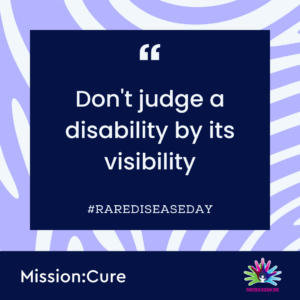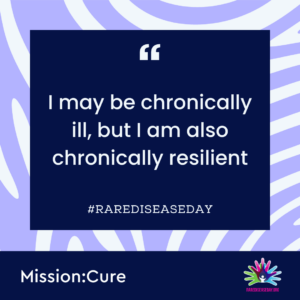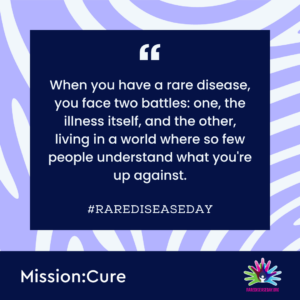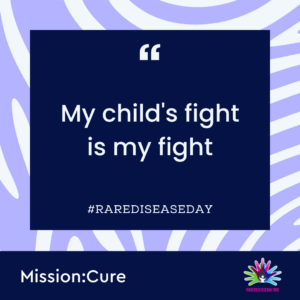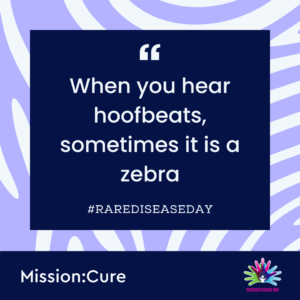There’s an old medical saying that doctors are taught while in medical school: “When you hear hoof beats, think horses, not zebras.” This medical slang teaches doctors that they should assume more common diseases are causing their patient’s symptoms before exploring less common diagnoses. This February, however, is all about the zebras – those whose diagnoses are anything but common.
What is Rare Disease Day?
Rare Disease Day is an international movement and awareness event that aims to shed light on what it means to live with a rare disease. It also inspires global audiences to support organizations that are working to develop new therapies, increase healthcare access, and improve treatments for those living with a rare disease.
Why is Rare Disease Day important?
Rare Disease Day gives people and communities a chance to advocate for rare diseases by presenting the needs of rare disease patients as a human rights issue. By advocating for the needs of those living with a rare disease on a local, national, and international level, Rare Disease Day aims to make our society more inclusive for people facing health challenges.
What is a rare disease?
According to the official Rare Disease Day website, a disease is considered rare when it affects less than 1 in 2,000 people. Over 300 million people worldwide live with a rare disease, which amounts to 3.5 to 5.9% of the global population. About 72% of all rare diseases are genetic, meaning they are inherited and caused by a DNA abnormality.
Rare Disease Day: List of Diseases
The following is a list of rare disease examples. For a comprehensive list, please visit the National Organization for Rare Diseases (Nord) Rare Disease Database.
- Addison’s Disease
- Alopecia Areata
- Bell’s Palsy
- Brucellosis
- Chronic/Hereditary Pancreatitis
- Congenital Heart Block
- Desmoid Tumor
- Dubin Johnson Syndrome
- Endocardial Fibroelastosis
- Eosinophilic Gastroenteritis
- Familial Lipoprotein Lipase Deficiency
- Functional Neurological Disorder
- Gastritis, Chronic, Erosive
- Growth Hormone Insensitivity
- Hodgkin’s Disease
- Hypochondroplasia
- IRF6-Related Disorders
- Ivemark Syndrome
- Jackson-Weiss Syndrome
- Juvenile CLN3 Disease
- Kienböck Disease
- Klippel-Feil Syndrome
- Leprosy
- Locked In Syndrome
- MN1 C-Terminal Truncation Syndrome
- Mulibrey Nanism
- Narcolepsy
- Nephrogenic Systemic Fibrosis
- Ocular Albinism
- Ovarian Cancer
- Pancreatic Neuroendocrine Neoplasms (pNENs)
- Perrault Syndrome
- Q fever
- Refractory Celiac Disease
- Retroperitoneal Fibrosis
- Short Bowel Syndrome
- Sickle Cell Disease
- Thyroid Cancer
- Trichorhinophalangeal Syndrome Type I
- UGDH-Related Disorder
- Ulcerative Colitis
- Von Hippel-Lindau Disease
- WAS Related Disorders
- Whipple Disease
- X-linked Retinoschisis
- XYY Syndrome
- Yellow Nail syndrome
- Yunis Varon Syndrome
- Zellweger Spectrum Disorders
- Zollinger-Ellison Syndrome
The History of Rare Disease Day
Rare Disease Day was launched and coordinated in 2008 by EURODIS (Rare Disease – Europe) and over 65 patient organization partners. The day is celebrated on the last day of February every year – typically on the 28th, but sometimes on the 29th during leap years – because it is the “rarest” day of the year.
In the United States, the National Organization for Rare Disorders (NORD) is proud to be the official US partner for Rare Disease Day. NORD works with EURODIS and other organizations around the world to help make Rare Disease Day a success.
Why the Zebra is the Rare Disease Day Symbol
The zebra is the official symbol of rare diseases in the United States, thanks to the quote, “when you hear hoof beats, think horses, not zebras.” This saying is intended to teach medical students to look for the most common cause for a medical condition before considering rarer causes. Since this approach can result in people with rare diseases being misdiagnosed and rare diseases being overlooked, the rare disease community has embraced the zebra mascot to represent those who do have a rare condition. As a result, people are encouraged to wear stripes with pride in honor of Rare Disease Day. People can wear stripes on their clothing or accessories, or even a Rare Disease Day zebra-striped ribbon.

Image source: NORD
When is Rare Disease Day?
Rare Disease Day is celebrated every year on the last day of February. Many organizations are hosting events this day and throughout the month of February, which you can find on the official Rare Disease Day website.
What is the Rare Disease Day 2023 theme?
The international Rare Disease Day theme for 2023 is #ShareYourColours, and in the United States, the theme is also #ShowYourStripes. Both themes call on rare disease patients and advocates to share their stories on social media, giving the community a visible way to bring attention to rare diseases through zebra-striped clothing and lighting up landmarks with the Rare Disease Day colors.
How can I support Rare Disease Day?
According to NORD, sharing a picture of you in your striped look with the hashtags #ShowYourStripes and #RareDiseaseDay can help “make some noise for our herd” by starting a conversation that helps people learn about rare diseases and their challenges.


